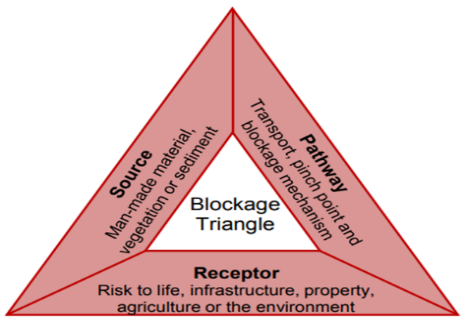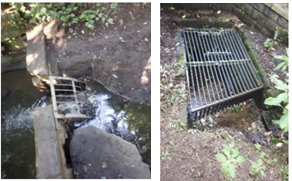Using nature-based solutions to reduce the amount of debris in watercourses in Kirklees, West Yorkshire.
iCASP and Kirklees Council are working on a project to come up with a solution to reduce the amount of debris in water courses. This is line in line with Environment Agency’s ‘Working With Natural Processes’ report (WWNP). The project uses nature based solutions to reduce blockages downstream, this helps the council to keep trash screens on waterways clear.
The primary focus of the project has been flood risk reduction, however, many of the methods offer multiple benefits such as improvements to habitat, biodiversity and water quality. A resource fact sheet has been produced to inform owners of watercourses of their responsibilities.
Watercourse Blockages
The Blocking Triangle – For a blockage to occur all three of these elements must be present.
Vegetation is the key component of debris loads in urban settings accounting for
- 85% in residential environments
- 36% in industrial environments

Trash Screens and Culverts
Trash screens and culverts are usually found in urban areas, many have are modern screens are designed to follow best practice guides although other screens pre-date such guidance.

For instance, water has been a driving force behind historic industrial processes – culverts, mill gates, weirs and manmade watercourses are commonplace in traditional mill towns across Yorkshire and Lancashire. However, historic trash screens and culverts are not up to date with current best practice.
Debris screens have been retrospectively added to many of these features to prevent blockages as the time in between maintenance has increased.
In many of these locations, the nature of the channel and culvert alongside limited financial resources, means redesigning culverts and trash screen is not a practical solution and regular clearance of trash screens is costly.An alternative approach is required that attempts to reduce the load reaching the trash screen.
An alternative approach is required that attempts to reduce the load reaching the trash screen.
How to Manage the Source of Blockages
Education
Education is an important part of the project as many land owners and residents are unaware of their responsibilities to keep culverts, river beds and banks clear of any matter that could cause an obstruction and to keep trash screens and other structures clear from the build-up of excessive debris or sediment.
Owners of water-courses have the following responsibilities:
- Allow water to flow naturally by removing blockages, fallen trees or overhanging branches from their watercourse. Trees and shrubs on the banks of a water course should be cut back.
- Prevent water pollution by removing litter from the banks and not allowing garden waste (including grass cuttings) to be disposed of in water.
Owners of culverts, screens and outfalls are responsible for:
- Passing on flow without obstruction, pollution or diversion, without affecting the rights of others
- Keeping the bed and banks clear of any matter that could cause an obstruction
- Keeping structures clear from the build-up of excessive debris or sediment
